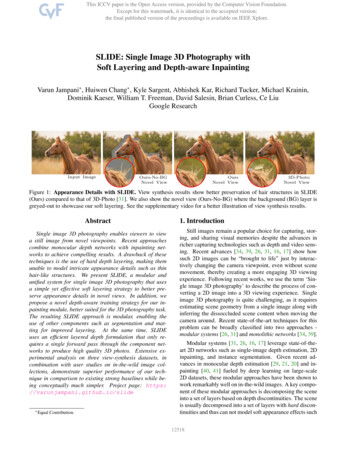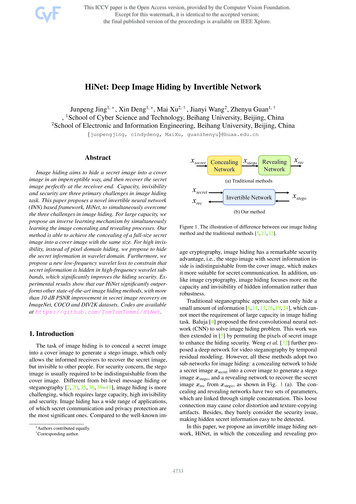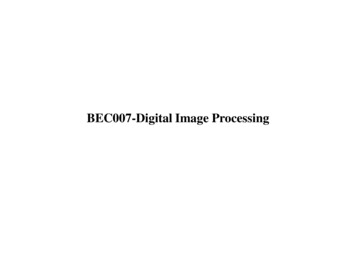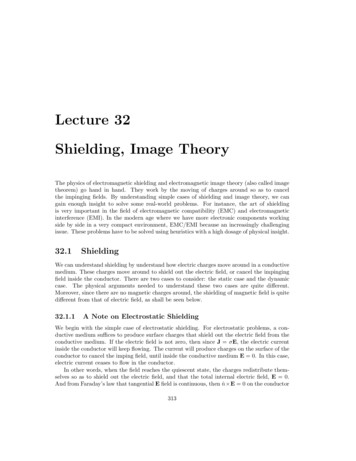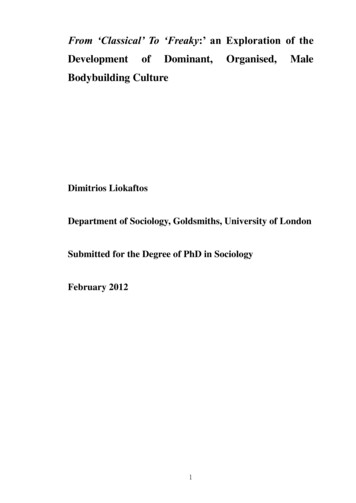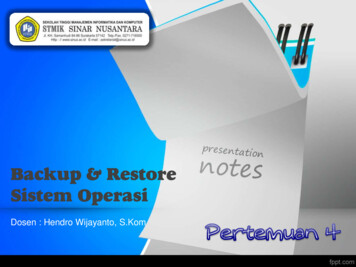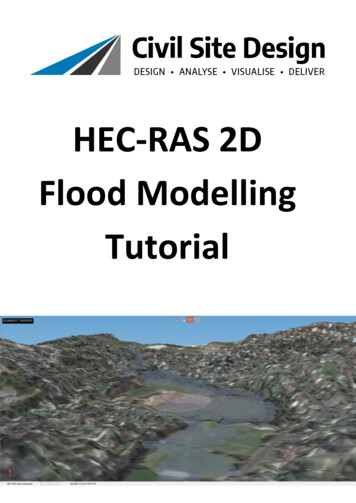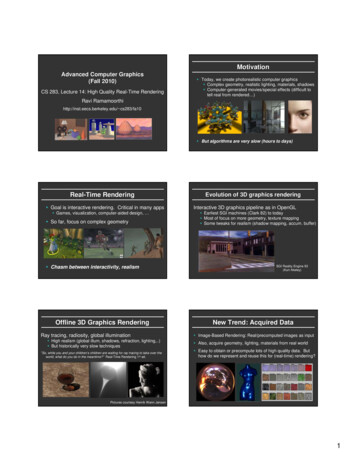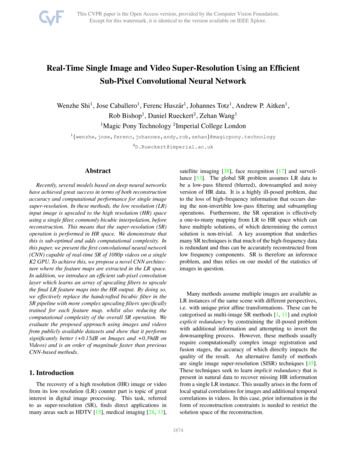
Transcription
Real-Time Single Image and Video Super-Resolution Using an EfficientSub-Pixel Convolutional Neural NetworkWenzhe Shi1 , Jose Caballero1 , Ferenc Huszár1 , Johannes Totz1 , Andrew P. Aitken1 ,Rob Bishop1 , Daniel Rueckert2 , Zehan Wang11Magic Pony Technology 2 Imperial College stractRecently, several models based on deep neural networkshave achieved great success in terms of both reconstructionaccuracy and computational performance for single imagesuper-resolution. In these methods, the low resolution (LR)input image is upscaled to the high resolution (HR) spaceusing a single filter, commonly bicubic interpolation, beforereconstruction. This means that the super-resolution (SR)operation is performed in HR space. We demonstrate thatthis is sub-optimal and adds computational complexity. Inthis paper, we present the first convolutional neural network(CNN) capable of real-time SR of 1080p videos on a singleK2 GPU. To achieve this, we propose a novel CNN architecture where the feature maps are extracted in the LR space.In addition, we introduce an efficient sub-pixel convolutionlayer which learns an array of upscaling filters to upscalethe final LR feature maps into the HR output. By doing so,we effectively replace the handcrafted bicubic filter in theSR pipeline with more complex upscaling filters specificallytrained for each feature map, whilst also reducing thecomputational complexity of the overall SR operation. Weevaluate the proposed approach using images and videosfrom publicly available datasets and show that it performssignificantly better ( 0.15dB on Images and 0.39dB onVideos) and is an order of magnitude faster than previousCNN-based methods.1. IntroductionThe recovery of a high resolution (HR) image or videofrom its low resolution (LR) counter part is topic of greatinterest in digital image processing. This task, referredto as super-resolution (SR), finds direct applications inmany areas such as HDTV [15], medical imaging [28, 33],satellite imaging [38], face recognition [17] and surveillance [53]. The global SR problem assumes LR data tobe a low-pass filtered (blurred), downsampled and noisyversion of HR data. It is a highly ill-posed problem, dueto the loss of high-frequency information that occurs during the non-invertible low-pass filtering and subsamplingoperations. Furthermore, the SR operation is effectivelya one-to-many mapping from LR to HR space which canhave multiple solutions, of which determining the correctsolution is non-trivial. A key assumption that underliesmany SR techniques is that much of the high-frequency datais redundant and thus can be accurately reconstructed fromlow frequency components. SR is therefore an inferenceproblem, and thus relies on our model of the statistics ofimages in question.Many methods assume multiple images are available asLR instances of the same scene with different perspectives,i.e. with unique prior affine transformations. These can becategorised as multi-image SR methods [1, 11] and exploitexplicit redundancy by constraining the ill-posed problemwith additional information and attempting to invert thedownsampling process. However, these methods usuallyrequire computationally complex image registration andfusion stages, the accuracy of which directly impacts thequality of the result. An alternative family of methodsare single image super-resolution (SISR) techniques [45].These techniques seek to learn implicit redundancy that ispresent in natural data to recover missing HR informationfrom a single LR instance. This usually arises in the form oflocal spatial correlations for images and additional temporalcorrelations in videos. In this case, prior information in theform of reconstruction constraints is needed to restrict thesolution space of the reconstruction.11874
Figure 1. The proposed efficient sub-pixel convolutional neural network (ESPCN), with two convolution layers for feature maps extraction,and a sub-pixel convolution layer that aggregates the feature maps from LR space and builds the SR image in a single step.1.1. Related WorkThe goal of SISR methods is to recover a HR image froma single LR input image [14]. Recent popular SISR methodscan be classified into edge-based [35], image statisticsbased [9, 18, 46, 12] and patch-based [2, 43, 52, 13, 54,40, 5] methods. A detailed review of more generic SISRmethods can be found in [45]. One family of approachesthat has recently thrived in tackling the SISR problem issparsity-based techniques. Sparse coding is an effectivemechanism that assumes any natural image can be sparselyrepresented in a transform domain. This transform domainis usually a dictionary of image atoms [25, 10], which canbe learnt through a training process that tries to discoverthe correspondence between LR and HR patches. Thisdictionary is able to embed the prior knowledge necessaryto constrain the ill-posed problem of super-resolving unseendata. This approach is proposed in the methods of [47, 8].A drawback of sparsity-based techniques is that introducingthe sparsity constraint through a nonlinear reconstruction isgenerally computationally expensive.Image representations derived via neural networks [21,49, 34] have recently also shown promise for SISR. Thesemethods, employ the back-propagation algorithm [22] totrain on large image databases such as ImageNet [30] in order to learn nonlinear mappings of LR and HR image patches. Stacked collaborative local auto-encoders are used in [4]to super-resolve the LR image layer by layer. Osendorfer etal. [27] suggested a method for SISR based on an extensionof the predictive convolutional sparse coding framework[29]. A multiple layer convolutional neural network (CNN)inspired by sparse-coding methods is proposed in [7]. Chenet. al. [3] proposed to use multi-stage trainable nonlinearreaction diffusion (TNRD) as an alternative to CNN wherethe weights and the nonlinearity is trainable. Wang et. al[44] trained a cascaded sparse coding network from end toend inspired by LISTA (Learning iterative shrinkage andthresholding algorithm) [16] to fully exploit the naturalsparsity of images. The network structure is not limited toneural networks, for example, a random forest [31] has alsobeen successfully used for SISR.1.2. Motivations and contributionsFigure 2. Plot of the trade-off between accuracy and speed fordifferent methods when performing SR upscaling with a scalefactor of 3. The results presents the mean PSNR and run-timeover the images from Set14 run on a single CPU core clocked at2.0 GHz.With the development of CNN, the efficiency of the algorithms, especially their computational and memory cost,gains importance [36]. The flexibility of deep network models to learn nonlinear relationships has been shown to attainsuperior reconstruction accuracy compared to previouslyhand-crafted models [27, 7, 44, 31, 3]. To super-resolvea LR image into HR space, it is necessary to increase theresolution of the LR image to match that of the HR imageat some point.In Osendorfer et al. [27], the image resolution isincreased in the middle of the network gradually. Anotherpopular approach is to increase the resolution before orat the first layer of the network [7, 44, 3]. However,this approach has a number of drawbacks. Firstly, increasing the resolution of the LR images before the image1875
enhancement step increases the computational complexity.This is especially problematic for convolutional networks,where the processing speed directly depends on the inputimage resolution. Secondly, interpolation methods typicallyused to accomplish the task, such as bicubic interpolation[7, 44, 3], do not bring additional information to solve theill-posed reconstruction problem.Learning upscaling filters was briefly suggested in thefootnote of Dong et.al. [6]. However, the importance ofintegrating it into the CNN as part of the SR operationwas not fully recognised and the option not explored.Additionally, as noted by Dong et al. [6], there are noefficient implementations of a convolution layer whoseoutput size is larger than the input size and well-optimizedimplementations such as convnet [21] do not trivially allowsuch behaviour.In this paper, contrary to previous works, we propose toincrease the resolution from LR to HR only at the very endof the network and super-resolve HR data from LR featuremaps. This eliminates the need to perform most of the SRoperation in the far larger HR resolution. For this purpose,we propose a more efficient sub-pixel convolution layer tolearn the upscaling operation for image and video superresolution.The advantages of these contributions are two fold: In our network, upscaling is handled by the last layerof the network. This means each LR image is directly fed to the network and feature extraction occursthrough nonlinear convolutions in LR space. Due tothe reduced input resolution, we can effectively usea smaller filter size to integrate the same informationwhile maintaining a given contextual area. The resolution and filter size reduction lower the computationaland memory complexity substantially enough to allowsuper-resolution of high definition (HD) videos in realtime as shown in Sec. 3.5. For a network with L layers, we learn nL 1 upscalingfilters for the nL 1 feature maps as opposed to oneupscaling filter for the input image. In addition, notusing an explicit interpolation filter means that the network implicitly learns the processing necessary for SR.Thus, the network is capable of learning a better andmore complex LR to HR mapping compared to a singlefixed filter upscaling at the first layer. This results inadditional gains in the reconstruction accuracy of themodel as shown in Sec. 3.3.2 and Sec. 3.4.We validate the proposed approach using images andvideos from publicly available benchmarks datasets andcompared our performance against previous works including [7, 3, 31]. We show that the proposed model achievesstate-of-art performance and is nearly an order of magnitudefaster than previously published methods on images andvideos.2. MethodThe task of SISR is to estimate a HR image ISRgiven a LR image ILR downscaled from the correspondingoriginal HR image IHR . The downsampling operation isdeterministic and known: to produce ILR from IHR , wefirst convolve IHR using a Gaussian filter - thus simulatingthe camera’s point spread function - then downsample theimage by a factor of r. We will refer to r as the upscalingratio. In general, both ILR and IHR can have C colourchannels, thus they are represented as real-valued tensors ofsize H W C and rH rW C, respectively.To solve the SISR problem, the SRCNN proposed in [7]recovers from an upscaled and interpolated version of ILRinstead of ILR . To recover ISR , a 3 layer convolutionalnetwork is used. In this section we propose a novel networkarchitecture, as illustrated in Fig. 1, to avoid upscaling ILRbefore feeding it into the network. In our architecture, wefirst apply a l layer convolutional neural network directly tothe LR image, and then apply a sub-pixel convolution layerthat upscales the LR feature maps to produce ISR .For a network composed of L layers, the first L 1 layerscan be described as follows: f 1 (ILR ; W1 , b1 ) φ W1 ILR b1 , f l (ILR ; W1:l , b1:l ) φ Wl f l 1 ILR bl ,(1)(2)Where Wl , bl , l (1, L 1) are learnable networkweights and biases respectively. Wl is a 2D convolutiontensor of size nl 1 nl kl kl , where nl is the number offeatures at layer l, n0 C, and kl is the filter size at layerl. The biases bl are vectors of length nl . The nonlinearityfunction (or activation function) φ is applied element-wiseand is fixed. The last layer f L has to convert the LR featuremaps to a HR image ISR .2.1. Deconvolution layerThe addition of a deconvolution layer is a popularchoice for recovering resolution from max-pooling andother image down-sampling layers. This approach hasbeen successfully used in visualizing layer activations [49]and for generating semantic segmentations using high levelfeatures from the network [24]. It is trivial to show thatthe bicubic interpolation used in SRCNN is a special caseof the deconvolution layer, as suggested already in [24, 7].The deconvolution layer proposed in [50] can be seen asmultiplication of each input pixel by a filter element-wisewith stride r, and sums over the resulting output windowsalso known as backwards convolution [24]. However, anyreduction (summing) after convolution is expensive.1876
2.2. Efficient sub-pixel convolution layerfilter for each feature map as shown in Fig. 4.Given a training set consisting of HR image examplesIHRn , n 1 . . . N , we generate the corresponding LRimages ILRn , n 1 . . . N , and calculate the pixel-wise meansquared error (MSE) of the reconstruction as an objectivefunction to train the network:Figure 3. The first-layer filters trained on ImageNet with an upscaling factor of 3. The filters are sorted based on their variances.rWrH XX 1LLR 2IHR)x,y fx,y (I2r HW x 1 x 1(5)It is noticeable that the implementation of the aboveperiodic shuffling can be very fast compared to reductionor convolution in HR space because each operation isindependent and is thus trivially parallelizable in one cycle.Thus our proposed layer is log2 r2 times faster comparedto deconvolution layer in the forward pass and r2 timesfaster compared to implementations using various forms ofupscaling before convolution.The other way to upscale a LR image is convolutionwith fractional stride of 1r in the LR space as mentioned by[24], which can be naively implemented by interpolation,perforate [27] or un-pooling [49] from LR space to HRspace followed by a convolution with a stride of 1 in HRspace. These implementations increase the computationalcost by a factor of r2 , since convolution happens in HRspace.Alternatively, a convolution with stride of 1r in the LR space with a filter Ws of size ks with weight spacing 1r wouldactivate different parts of Ws for the convolution. Theweights that fall between the pixels are simply not activatedand do not need to be calculated. The number of activationpatterns is exactly r2 . Each activation pattern, according2to its location, has at most ⌈ krs ⌉ weights activated. Thesepatterns are periodically activated during the convolution ofthe filter across the image depending on different sub-pixellocation: mod (x, r) , mod (y, r) where x, y are the outputpixel coordinates in HR space. In this paper, we proposean effective way to implement the above operation whenmod (ks , r) 0: ISR f L (ILR ) PS WL f L 1 (ILR ) bL ,(3)where PS is an periodic shuffling operator that rearranges the elements of a H W C · r2 tensor to a tensorof shape rH rW C. The effects of this operation areillustrated in Fig. 1. Mathematically, this operation can bedescribed in the following wayPS(T )x,y,c T⌊x/r⌋,⌊y/r⌋,c·r·mod(y,r) c·mod(x,r)(4)The convolution operator WL thus has shape nL 1 r2 C kL kL . Note that we do not apply nonlinearity tothe outputs of the convolution at the last layer. It is easy tosee that when kL krs and mod (ks , r) 0 it is equivalentto sub-pixel convolution in the LR space with the filter Ws .We will refer to our new layer as the sub-pixel convolutionlayer and our network as efficient sub-pixel convolutionalneural network (ESPCN). This last layer produces a HRimage from LR feature maps directly with one upscalingℓ(W1:L , b1:L ) 3. ExperimentsThe detailed report of quantitative evaluation including the original data including images and videos, downsampled data, super-resolved data, overall and individualscores and run-times on a K2 GPU are provided in thesupplemental material.3.1. DatasetsDuring the evaluation, we used publicly available benchmark datasets including the Timofte dataset [40] widelyused by SISR papers [7, 44, 3] which provides sourcecode for multiple methods, 91 training images and twotest datasets Set5 and Set14 which provides 5 and 14images; The Berkeley segmentation dataset [26] BSD300and BSD500 which provides 100 and 200 images fortesting and the super texture dataset [5] which provides136 texture images. For our final models, we use 50,000randomly selected images from ImageNet [30] for thetraining. Following previous works, we only consider theluminance channel in YCbCr colour space in this sectionbecause humans are more sensitive to luminance changes[31]. For each upscaling factor, we train a specific network.For video experiments we use 1080p HD videos fromthe publicly available Xiph database1 , which has been usedto report video SR results in previous methods [37, 23].The database contains a collection of 8 HD videos approximately 10 seconds in length and with width and height1920 1080. In addition, we also use the Ultra VideoGroup database2 , containing 7 videos of 1920 1080 in1 Xiph.org Video Test Media [derf’s collection] https://media.xiph.org/video/derf/2 Ultra Video Group Test Sequences http://ultravideo.cs.tut.fi/1877
Figure 4. The last-layer filters trained on ImageNet with an upscaling factor of 3: (a) shows weights from SRCNN 9-5-5 model [7], (b)shows weights from ESPCN (ImageNet relu) model and (c) weights from (b) after the PS operation applied to the r2 channels. The filtersare in their default ordering.(a) Baboon Original(b) Bicubic / 23.21db(c) SRCNN [7] / 23.67db(d) TNRD [3] / 23.62db(e) ESPCN / 23.72db(f) Comic Original(g) Bicubic / 23.12db(h) SRCNN [7] / 24.56db(i) TNRD [3] / 24.68db(j) ESPCN / 24.82db(k) Monarch Original(l) Bicubic / 29.43db(m) SRCNN [7] / 32.81db(n) TNRD [3] / 33.62db(o) ESPCN / 33.66dbFigure 5. Super-resolution examples for ”Baboon”, ”Comic” and ”Monarch” from Set14 with an upscaling factor of 3. PSNR values areshown under each sub-figure.1878
size and 5 seconds in length.3.2. Implementation detailsFor the ESPCN, we set l 3, (f1 , n1 ) (5, 64),(f2 , n2 ) (3, 32) and f3 3 in our evaluations. Thechoice of the parameter is inspired by SRCNN’s 3 layer 9-55 model and the equations in Sec. 2.2. In the training phase,17r 17r pixel sub-images are extracted from the trainingground truth images IHR , where r is the upscaling factor.To synthesize the low-resolution samples ILR , we blur IHRusing a Gaussian filter and sub-sample it by the upscalingfactor. The sub-imagesPare extracted from original imageswith a stride ofP(17 mod (f, 2)) r from IHR and astride of 17 mod (f, 2) from ILR . This ensures thatall pixels in the original image appear once and only onceas the ground truth of the training data. We choose tanhinstead of relu as the activation function for the final modelmotivated by our experimental results.The training stops after no improvement of the costfunction is observed after 100 epochs. Initial learningrate is set to 0.01 and final learning rate is set to 0.0001and updated gradually when the improvement of the costfunction is smaller than a threshold µ. The final layerlearns 10 times slower as in [7]. The training takes roughlythree hours on a K2 GPU on 91 images, and seven dayson images from ImageNet [30] for upscaling factor of 3.We use the PSNR as the performance metric to evaluateour models. PSNR of SRCNN and Chen’s models on ourextended benchmark set are calculated based on the Matlabcode and models provided by [7, 3].3.3. Image super-resolution results3.3.1Benefits of the sub-pixel convolution layerIn this section, we demonstrate the positive effect of the subpixel convolution layer as well as tanh activation function.We first evaluate the power of the sub-pixel convolutionlayer by comparing against SRCNN’s standard 9-1-5 model[6]. Here, we follow the approach in [6], using relu as theactivation function for our models in this experiment, andtraining a set of models with 91 images and another set withimages from ImageNet. The results are shown in Tab. 1.ESPCN with relu trained on ImageNet images achievedstatistically significantly better performance compared toSRCNN models. It is noticeable that ESPCN (91) performsvery similar to SRCNN (91). Training with more imagesusing ESPCN has a far more significant impact on PSNRcompared to SRCNN with similar number of parameters( 0.33 vs 0.07).To make a visual comparison between our model withthe sub-pixel convolution layer and SRCNN, we visualizedweights of our ESPCN (ImageNet) model against SRCNN9-5-5 ImageNet model from [7] in Fig. 3 and Fig. 4. Theweights of our first and last layer filters have a strong similarity to designed features including the log-Gabor filters[48], wavelets [20] and Haar features [42]. It is noticeablethat despite each filter is independent in LR space, ourindependent filters is actually smooth in the HR space afterPS. Compared to SRCNN’s last layer filters, our final layerfilters has complex patterns for different feature maps, italso has much richer and more meaningful representations.We also evaluated the effect of tanh activation functionbased on the above model trained on 91 images and ImageNet images. Results in Tab. 1 suggests that tanh functionperforms better for SISR compared to relu. The results forImageNet images with tanh activation is shown in Tab. 2.3.3.2Comparison to the state-of-the-artIn this section, we show ESPCN trained on ImageNetcompared to results from SRCNN [7] and the TNRD [3]which is currently the best performing approach published.For simplicity, we do not show results which are known tobe worse than [3]. For the interested reader, the results ofother previous methods can be found in [31]. We choose tocompare against the best SRCNN 9-5-5 ImageNet model inthis section [7]. And for [3], results are calculated based onthe 7 7 5 stages model.Our results shown in Tab. 2 are significantly better thanthe SRCNN 9-5-5 ImageNet model, whilst being close to,and in some cases out-performing, the TNRD [3]. AlthoughTNRD uses a single bicubic interpolation to upscale the input image to HR space, it possibly benefits from a trainablenonlinearity function. This trainable nonlinearity functionis not exclusive from our network and will be interestingto explore in the future. Visual comparison of the superresolved images is given in Fig. 5 and Fig. 6, the CNNmethods create a much sharper and higher contrast images,ESPCN provides noticeably improvement over SRCNN.3.4. Video super-resolution resultsIn this section, we compare the ESPCN trained modelsagainst single frame bicubic interpolation and SRCNN [7]on two popular video benchmarks. One big advantage ofour network is its speed. This makes it an ideal candidatefor video SR which allows us to super-resolve the videosframe by frame. Our results shown in Tab. 3 and Tab. 4are better than the SRCNN 9-5-5 ImageNet model. Theimprovement is more significant than the results on theimage data, this maybe due to differences between datasets.Similar disparity can be observed in different categories ofthe image benchmark as Set5 vs SuperTexture.1879
(a) 14092 Original(b) Bicubic / 29.06db(c) SRCNN [7] / 29.74db(d) TNRD [3] / 29.74db(e) ESPCN / 29.78db(f) 335094 Original(g) Bicubic / 22.24db(h) SRCNN [7] / 23.96db(i) TNRD [3] / 24.15db(j) ESPCN / 24.14db(k) 384022 Original(l) Bicubic / 25.42db(m) SRCNN [7] / 26.72db(n) TNRD [3] / 26.74db(o) ESPCN / 26.86dbFigure 6. Super-resolution examples for ”14092”, ”335094” and ”384022” from BSD500 with an upscaling factor of 3. PSNR values areshown under each eAverageScale333333SRCNN (91)32.3929.0028.2128.2826.3727.76ESPCN (91 relu)32.3928.9728.2028.2726.3827.76ESPCN (91)32.5529.0828.2628.3426.4227.82SRCNN (ImageNet)32.5229.1428.2928.3726.4127.83ESPCN (ImageNet relu)33.0029.4228.5228.6226.6928.09Table 1. The mean PSNR (dB) for different models. Best results for each category are shown in bold. There is significant differencebetween the PSNRs of the proposed method and other methods (p-value 0.001 with paired t-test).3.5. Run time evaluationsIn this section, we evaluated our best model’s run time onSet143 with an upscale factor of 3. We evaluate the run timeof other methods [2, 51, 39] from the Matlab codes providedby [40] and [31]. For methods which use convolutions including our own, a python/theano implementation is used toimprove the efficiency based on the Matlab codes providedin [7, 3]. The results are presented in Fig. 2. Our modelruns a magnitude faster than the fastest methods publishedso far. Compared to SRCNN 9-5-5 ImageNet model, thenumber of convolution required to super-resolve one imageis r r times smaller and the number of total parameters ofthe model is 2.5 times smaller. The total complexity of the3 Itshould be noted our results outperform all other algorithms inaccuracy on the larger BSD datasets. However, the use of Set14 on a singleCPU core is selected here in order to allow a straight-forward comparisonwith results from previous published results [31, 6].super-resolution operation is thus 2.5 r r times lower.We have achieved a stunning average speed of 4.7ms forsuper-resolving one single image from Set14 on a K2 GPU.Utilising the amazing speed of the network, it will be interesting to explore ensemble prediction using independentlytrained models as discussed in [36] to achieve better SRperformance in the future.We also evaluated run time of 1080 HD video superresolution using videos from the Xiph and the Ultra VideoGroup database. With upscale factor of 3, SRCNN 9-5-5ImageNet model takes 0.435s per frame whilst our ESPCNmodel takes only 0.038s per frame. With upscale factor of4, SRCNN 9-5-5 ImageNet model takes 0.434s per framewhilst our ESPCN model takes only 0.029s per frame.1880
27.0725.0726.53Table 2. The mean PSNR (dB) of different methods evaluated onour extended benchmark set. Where SRCNN stands for the SRCNN 9-5-5 ImageNet model [7], TNRD stands for the TrainableNonlinear Reaction Diffusion Model from [3] and ESPCN standsfor our ImageNet model with tanh activation. Best results foreach category are shown in bold. There is significant differencebetween the PSNRs of the proposed method and SRCNN (p-value 0.01 with paired 9136.9425.1331.8330.5425.6426.4031.67Table 3. Results on HD videos from Xiph database. WhereSRCNN stands for the SRCNN 9-5-5 ImageNet model [7] andESPCN stands for our ImageNet model with tanh activation.Best results for each category are shown in bold. There issignificant difference between the PSNRs of the proposed methodand SRCNN (p-value 0.01 with paired t-test)4. ConclusionIn this paper, we demonstrate that fixed filter upscalingat the first layer does not provide any extra informationfor SISR yet requires more computational complexity. Toaddress the problem, we propose to perform the featureextraction stages in the LR space instead of HR space.To do that we propose a novel sub-pixel convolution layerwhich is capable of super-resolving LR data into HR spacewith very little additional computational cost 937.1140.8741.9237.91Table 4. Results on HD videos from Ultra Video Group database.Where SRCNN stands for the SRCNN 9-5-5 ImageNet model [7]and ESPCN stands for our ImageNet model with tanh activation.Best results for each category are shown in bold. There issignificant difference between the PSNRs of the proposed methodand SRCNN (p-value 0.01 with paired t-test)to a deconvolution layer [50]. Evaluation performed onan extended bench mark data set with upscaling factor of4 shows that we have a significant speed ( 10 ) andperformance ( 0.15dB on Images and 0.39dB on videos)boost compared to the previous CNN approach with moreparameters [7] (5-3-3 vs 9-5-5). This makes our model thefirst CNN model that is capable of SR HD videos in realtime on a single GPU.5. Future workA reasonable assumption when processing video information is that most of a scene’s content is shared byneighbouring video frames. Exceptions to this assumptionare scene changes and objects sporadically appearing ordisappearing from the scene. This creates additional dataimplicit redundancy that can be exploited for video superresolution as has been shown in [32, 23]. Spatio-temporalnetworks are popular as they fully utilise the temporal information from videos for human action recognition [19, 41].In the future, we will investigate extending our ESPCNnetwork into a spatio-temporal network to super-resolveone frame from multiple neighbouring frames using 3Dconvolutions.References[1] S. Borman and R. L. Stevenson. Super-Resolution from ImageSequences - A Review. Midwest Symposium on Circuits and Systems,pages 374–378, 1998. 1[2] H. Chang, D.-Y. Yeung, and Y. Xiong. Super-resolution throughneighbor embedding. In IEEE Computer Society Conference onComputer Vision and Pattern Recognition (CVPR),
is usually a dictionary of image atoms [25, 10], which can be learnt through a training process that tries to discover the correspondence between LR and HR patches. This dictionary is able to embed the prior knowledge necessary een d

